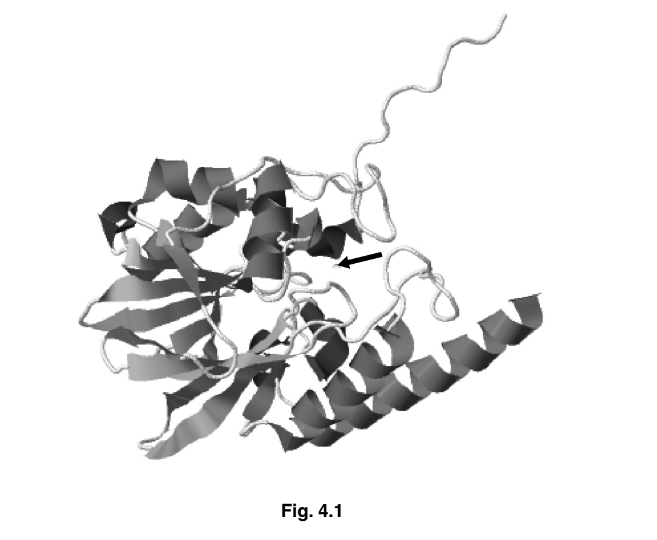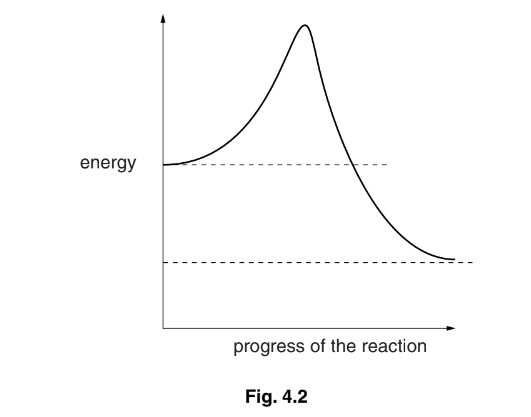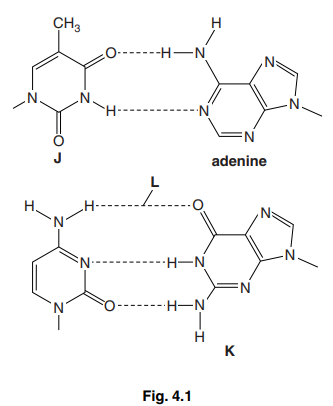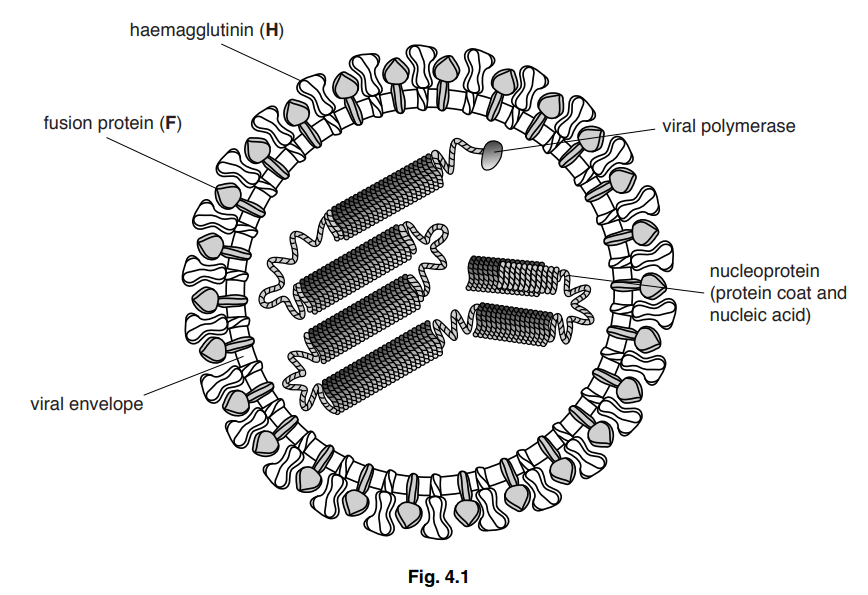Question [Maximum marks: 11]
Penicillin is an antibiotic that interferes with the synthesis of cell walls in bacteria. Even before
penicillin became widely available in the 1940s, the enzyme penicillinase which breaks down
penicillin had been isolated. This enzyme is now found in many bacteria and gives them
resistance to penicillin.
Fig. 4.1 is a ribbon model of the structure of the enzyme penicillinase. The arrow indicates
the active site of the enzyme.

(a) Explain why the shape of the active site of an enzyme, such as penicillinase, is important.
(b) With reference to Fig. 4.1, identify the aspects of protein structure that are shown and
those that are not shown.
Fig. 4.2 shows the changes in energy during the progress of an uncatalysed reaction.

(c) (i) Draw on Fig. 4.2 a curve to show changes in energy during the progress of the
same reaction when catalysed by an enzyme.
(ii) State the term given to the energy level that must be overcome before a reaction can progress.
(d) Antibiotic resistance is a serious worldwide problem.
Suggest how antibiotics can be used effectively to avoid the development of widespread
resistance in bacteria.
Answer/Explanation
Answer: 4(a) this can be answered in the context of penicillinase
1 complementary shape ;
2 substrate, fits into / enters / binds to / with, active site ;
A enzyme-substrate complex / ESC
3 ref. to specificity ;
4 lock and key / induced fit ; A description of induced fit
5 ref. to temporary bonds form with, active site / R groups (of amino acid residues) ; [max 3]
4(b) shown to max 2
secondary structure ;
α / alpha, helix ; R ‘helix’ / helical structure unqualified by alpha
β pleated sheet ;
tertiary structure / folding ; ignore 3D shape or structure
globular ;
not shown to max 2
amino acids / primary structure / sequence of amino acids ;
(types of) R groups ;
bonds / named bonds ; A peptide
quaternary structure ;
prosthetic group ; [max 3]
4(c) (i) one lower peak inside line than uncatalysed ;
start and finish at, dotted lines / same energy levels as uncatalysed ;
(ii) activation (energy) / (energy of) activation ;
4(d) 1 do not prescribe for viral diseases ;
2 only use when necessary / do not overprescribe ;
3 only available on prescription / not available ‘over the counter’ ;
4 people must, complete the course / take as instructed ;
R take a long course
5 test to find out which is most appropriate antibiotic to use ;
A use most, appropriate / effective, antibiotics
A use narrow-spectrum antibiotics
6 details of sensitivity test ;
7 rotate / AW, antibiotics / use in combination ; R use many antibiotics
8 do not use same antibiotics for humans and animals ; [max 2]
Question
Fig. 4.1 shows the two base pairs in a DNA molecule.

(a) Name the bases labelled J and K and the bond labelled L.[3]
J
K
L
HIV enters T-lymphocytes by a form of endocytosis. Two of the enzymes in HIV are:
- reverse transcriptase, which uses viral RNA as a template to make DNA to incorporate into the chromosomes of the host’s cells
- protease, which is used to break a polypeptide into smaller molecules. These molecules are used to make the protein coat of new viral particles, which will infect other cells.
Various drugs have been developed to treat HIV infections. Table 4.1 gives information about some of these drugs.

(b) Explain the difference between the mode of action of zidovudine and efavirenz.[4]
(c) People who receive drug treatment for HIV take a mixture of drugs that act in different ways.
Suggest the advantage of taking a mix of the drugs shown in Table 4.1.[2]
(d) Antibiotics are prescribed to people who have HIV/AIDS for the treatment of secondary infections, but not to treat the HIV infection.
Explain why this is so.[2] [Total: 11]
Answer/Explanation
Ans:
4 (a) J thymine ;
K guanine ;
L hydrogen bond ;
ignore H/H2 bond
(b) 1 zidovudine , competitive inhibitor and efavirenz , non-competitive ;
2 zidovudine, complementary to active site ;
3 efavirenz, binds to allosteric site/reference to allostery ;
4 efavirenz changes the, shape/ structure, of the active site ;
A denatures / changes tertiary structure so substrate will not fit
R changes shape unqualified
5 either
the effect of zidovudine is, reduced/reversed, by increasing the substrate
concentration
or
the effect of efavirenz is not, reduced/reversed, by increasing the substrate concentration ;
(c) 1 virus may be resistant to one or more of the drugs / very low chances that HIV is resistant to all of the drugs ;
R virus immune
2 (resistance due to) change to, active site/ allosteric site/ tertiary structure, of enzyme ;
A drug can no longer fit into active site
3 some drugs may be more effective than others /AW ;
4 reduces risk of drug resistance developing ;
5 HIV, has a high mutation rate/ changes surface proteins / changes antigens ;
A antigen(ic), shift/ drift
6 person may have mixture of strains of HIV ;
7 idea that virus will be at different stages in its, life/replication, cycle ;
8 AVP ;
e.g. more than one competitive to reduce chances of, ES complexes /AW
drugs work better in combination/ synergy idea
drugs inhibiting two different enzymes, so more effective
(d) 1 antibiotics are not effective against HIV or viruses / antibiotics are effective against, (named) bacteria/ bacterial disease ;
A fungi/ protoctists / protists / malaria
R antibiotics prevent infection
2 idea that viruses have no, sites / targets, where antibiotics can work ;
3 viruses have no, cell walls /ribosomes / cell membranes ;
A have different enzymes
4 viruses are within cells, idea that antibiotics cannot reach them ;
5 people with HIV are more susceptible to bacterial infections /reference to immune suppression/weak immune system ;
Question
Morbillivirus, which causes measles, and the human immunodeficiency virus (HIV) share these common features:
- outer envelope surrounding the protein coat
- RNA as the genetic material
- infect cells of the immune system.
(a) Compare the modes of transmission of Morbillivirus and HIV.[4]
(b) Antibiotics are not used to treat viral infections.
Explain why antibiotics do not affect viruses.[2]
(c) The structure of Morbillivirus is shown in Fig. 4.1.
Haemagglutinin (H) and fusion protein (F) are glycoproteins embedded in the viral envelope.

Morbillivirus only infects cells that have a membrane glycoprotein known as signalling lymphocyte activation molecule (SLAM).
When Morbillivirus infects a cell, H acts before F. After the virus binds to the host cell, only the nucleoprotein with the viral polymerase enters the host cell and the virus is replicated.
New viral particles leave the host cell by budding from the cell surface membrane of the cell. This forms the main part of their envelope.
With reference to Fig. 4.1 and the information provided on pages 9 and 10,
(i) outline the structural features of the viral envelope of Morbillivirus.[2]
(ii) suggest how Morbillivirus infects a cell with SLAM glycoproteins so that only nucleoprotein and viral polymerase enter.[3]
(iii) suggest the role of viral polymerase in Morbillivirus.[2]
(d) HIV has an antigen known as p24.
One test for an early diagnosis of HIV infection uses a monoclonal antibody that identifies antigen p24.
(i) State the type of biological molecule that is represented by antigen p24.[1]
(ii) Outline how the monoclonal antibody against antigen p24 is produced.[3] [Total: 17]
Answer/Explanation
Ans:
4 (a) Morbillivirus
aerosol/ droplet, infection ;
A described, e.g. (from infected person) in, exhaled/airborne, droplets, and inhaled
idea of spread by touching an infected surface and putting fingers into mouth/ nose ;
R contact without qualification
HIV
sexual intercourse/ passed via semen/ passed via vaginal fluids /AW ; blood transmission ; A described, e.g. blood transfusion
sharing (contaminated), needles / syringes accept transmitted in body fluids for one mark if above two points not gained
mother to, foetus / baby, transmission ;
A described, e.g. across placenta/ during birth/ breastfeeding
AVP ; e.g. ref. to measles mode of transmission leading to faster spread of disease/ ora
(b) antibiotics (only) used against bacteria (and some fungi) ; I used in malaria
idea that antibiotics act at a cell structure not possessed by virus ;
e.g. viruses, do not have, a cell wall/ a cell surface membrane/ribosomes
suggestion that viruses are, inside host cells / not within reach ;
antibiotics act only on, living/ growing, cells (viruses do not grow) ;
antibiotics do not act on, protein coat/ capsid/ capsomeres / viral envelope ;
(c) (i) phospholipid bilayer ;
proteins / glycoproteins / named ; I cholesterol
(ii) SLAM acts as a receptor ;
haemagglutinin/H/(viral) glycoprotein, binds to/ fits into/ complementary to, SLAM /receptor ;
fusion protein/F/(viral) glycoprotein, causes fusion (of envelope) to cell surface membrane ;
A (viral) envelope fuses with cell surface membrane fusion releases nucleoprotein (and viral polymerase) ;
(iii) in context of viral RNA
replication of RNA/ to make copies of genes /AW ;
transcription/ production of mRNA ;
detail ; e.g. to make viral proteins ;
AVP ; e.g. credit suggestion of, RNA-dependent DNA polymerase/reverse transcriptase, to produce viral DNA
(d) (i) protein ; A polypeptide A glycoprotein
(ii) immunise/ inject/AW, mice / small mammals, with p24/antigen ;
immune response occurs / leave for a number of weeks ; A description
harvest/ collect/AW, splenocytes /B-lymphocytes /B-cells / plasma cells ;
fuse with, myeloma cells / cancer cells ; A tumour
form hybridoma cells ;
select for (hybridoma) cells secreting antibody against, p24/antigen ;
